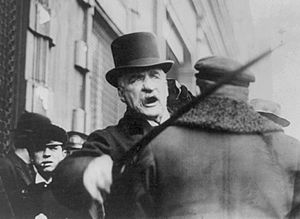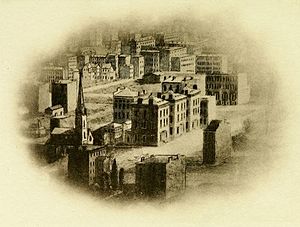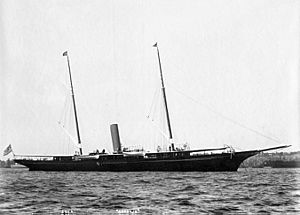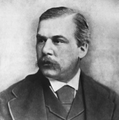J. P. Morgan facts for kids
Quick facts for kids
J. P. Morgan
|
|
|---|---|
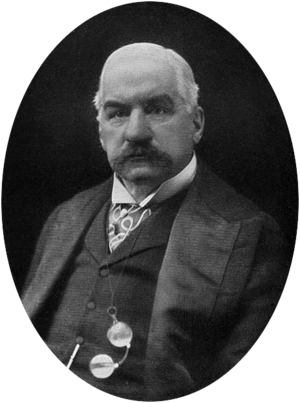 |
|
| Born |
John Pierpont Morgan
April 17, 1837 Hartford, Connecticut, U.S.
|
| Died | March 31, 1913 (aged 75) |
| Resting place | Cedar Hill Cemetery, Hartford, Connecticut, U.S. |
| Education | English High School of Boston |
| Alma mater | University of Göttingen (B.A.) |
| Occupation | Financier, banker, art collector |
| Spouse(s) |
Amelia Sturges
(m. 1861; died 1862)Frances Louise Tracy
(m. 1865) |
| Children | Louisa Pierpont Morgan John Pierpont Morgan, Jr. Juliet Morgan Anne Morgan |
| Parent(s) | Junius Spencer Morgan Juliet Pierpont |
| Signature | |
John Pierpont Morgan Sr. (April 17, 1837 – March 31, 1913) was a very powerful American financier and banker. He was a major force in corporate finance and bringing big companies together in the United States. This happened in the late 1800s and early 1900s.
In 1892, Morgan helped merge two big electric companies. They became General Electric, which is still a huge company today. He also played key roles in forming other giant companies. These included the United States Steel Corporation, International Harvester, and AT&T.
At the peak of his career, Morgan and his business partners had money invested in many large companies. They had a lot of influence over the nation's finances. He even led a group of banks that stopped a big financial crisis in 1907. Morgan was a leading figure during the Progressive Era. His focus on making things efficient helped change American business. Many people, like writer Adrian Wooldridge, called Morgan America's "greatest banker."
Morgan passed away in Rome, Italy, in 1913. He was 75 years old. He left his money and business to his son, John Pierpont Morgan Jr.. One writer, Ron Chernow, said Morgan's fortune was about $80 million. This made John D. Rockefeller famously say, "and to think, he wasn't even a rich man."
Contents
Early Life
Morgan was born into the important Morgan family in Hartford, Connecticut. He grew up there. In 1848, Pierpont went to Hartford Public School. Later, he attended the Episcopal Academy in Cheshire, Connecticut. This school is now called Cheshire Academy.
In September 1851, Morgan passed the test to get into The English High School of Boston. This school focused on math. It prepared young men for jobs in business. In 1852, Morgan got sick with Rheumatic fever. This illness caused him a lot of pain and made it hard for him to walk.
Appearance
Morgan had a strong effect on people when they met him. One person said a visit from Morgan felt "as if a gale had blown through the house." Morgan was a large man with broad shoulders and sharp eyes. He had a reddish-purple nose due to a skin condition called rosacea. He did not like publicity and hated having his picture taken. Because he was self-conscious about his nose, all his official portraits were changed to make it look better.
His nose was affected by a condition called rhinophyma, which can happen with rosacea. Despite this, his confidence in business and social settings was very strong. He seemed to challenge people to look at him directly. He showed that his strong personality was more important than his appearance. Morgan smoked many cigars every day. He liked large Havana cigars that people called Hercules' Clubs.
Career Highlights
Starting Out
When J.P. Morgan was 20, he began working as a banker in his father’s office in London. Later, he moved to Duncan, Sherman & Company in New York City.
He was very good at banking and worked with many other companies. J.P. Morgan bought businesses and was very involved in running them. He had a special way of reorganizing companies, which was called “Morganization.” In 1895, he renamed his own company J.P. Morgan & Company. It soon became one of the most powerful banks in the world.
Building Big Businesses
J.P. Morgan took control of many railroad companies. He also helped finance and reorganize railroads all across the U.S.. He later bought the Leyland Line of Atlantic Steamships and other boat companies. This included the White Star Line, which built the famous RMS Titanic. He also brought several steel companies together to create the United States Steel Corporation.
The Panic of 1893
During a financial crisis in 1893, there was a shortage of gold. This caused the value of the U.S. Dollar to drop. The U.S. president, Grover Cleveland, asked J.P. Morgan for help. Morgan loaned $65 million in gold to the U.S. Treasury. This loan helped "save" the Treasury and the U.S. Dollar.
Facing Criticism
Some people criticized Morgan for several reasons. They didn't like the terms of his gold loan to the U.S. government in 1895. They also questioned how he handled the financial crisis of 1907. Some felt he caused problems for the Hartford Railroad company. Others accused him of trying to create a monopoly with the U.S. Steel Corporation. They believed he wanted to control the making of bridges, ships, railroad cars, and other steel products.
His Homes
Morgan's house at 219 Madison Avenue was built in 1853. Morgan bought it in 1882. It became the first private home in New York to have electric lights. He was interested in this new technology because he had helped finance Thomas Alva Edison's Edison Illuminating Company in 1878.
A large party for 1,000 people was held there in 1894. It was for the wedding of his daughter, Juliet Morgan. Morgan also owned East Island in Glen Cove, New York. He had a big summer house there.
Love for Yachts
Morgan loved yachts and owned several large ones. A famous saying, "If you have to ask the price, you can't afford it," is often said to be his. He supposedly said it when asked about the cost of keeping a yacht. However, this story is not fully confirmed. Some say his son, J. P. Morgan Jr., said it about his own yacht, Corsair IV, in 1930.
Morgan was supposed to travel on the first trip of the RMS Titanic. But he canceled at the last minute. He chose to stay at a resort in France instead. The White Star Line, which owned the Titanic, was part of Morgan's company. Morgan was supposed to have his own private suite on the ship. After the Titanic sank, Morgan reportedly said, "Monetary losses amount to nothing in life. It is the loss of life that counts. It is that frightful death."
Art and Gem Collector
Morgan was a famous collector of books, pictures, paintings, and other art. He loaned or gave many pieces to the Metropolitan Museum of Art. He was also the president of this museum and helped start it. Many of his collections were kept in his London house and his private library in New York City. His son, J. P. Morgan Jr., opened the Pierpont Morgan Library to the public in 1924. He did this to honor his father.
Gemstone Collection
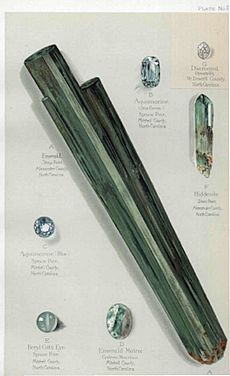
By the early 1900s, Morgan was one of America's most important gem collectors. He had gathered the most important collection of gems in the U.S. This included over 1,000 American gemstones. Tiffany & Co. helped him put together his first collection. It was led by their chief gem expert, George Frederick Kunz. This collection was shown at the World's Fair in Paris in 1889. It won two gold awards and got a lot of attention.
George Frederick Kunz continued to build an even better collection. It was shown in Paris in 1900. These collections were later given to the American Museum of Natural History in New York. They are known as the Morgan-Tiffany and Morgan-Bement collections. In 1911, Kunz named a new gem after Morgan. It was called morganite.
Supporting Photography
Morgan also supported photographer Edward S. Curtis. In 1906, Morgan offered Curtis $75,000. This money was for Curtis to create a series of photos about American Indians. Curtis eventually published a 20-volume work called The North American Indian. Curtis also made a movie, In the Land of the Head Hunters (1914). It was later restored and re-released as In the Land of the War Canoes.
Death and Legacy
Morgan died while traveling on March 31, 1913. He was almost 76 years old. He passed away in his sleep at a hotel in Rome, Italy. Flags on Wall Street were lowered to half-staff. The stock market even closed for two hours when his body passed through New York City. This honor is usually only for heads of state.
His body was brought to his home and library in New York City for the first night. He was buried in the Cedar Hill Cemetery in his hometown of Hartford, Connecticut. His son, John Pierpont "Jack" Morgan Jr., took over the banking business.
Morgan left his mansion and large book collections to the Morgan Library & Museum in New York. His total wealth was estimated at about $68.3 million. This included his share in the banks and his art collection.
JP Morgan was one of the richest men in the world. He built his wealth by buying and taking over many companies. Often, these companies became very large, almost like monopolies.
The JP Morgan Company still exists today. It is now called JPMorgan Chase and is owned by stockholders. Today, it is one of the oldest and leading banks in the world.
Images for kids
-
"I Like a Little Competition"—J. P. Morgan by Art Young. Cartoon relating to the answer Morgan gave when asked whether he disliked competition at the Pujo Committee.
See also
 In Spanish: J. P. Morgan para niños
In Spanish: J. P. Morgan para niños


